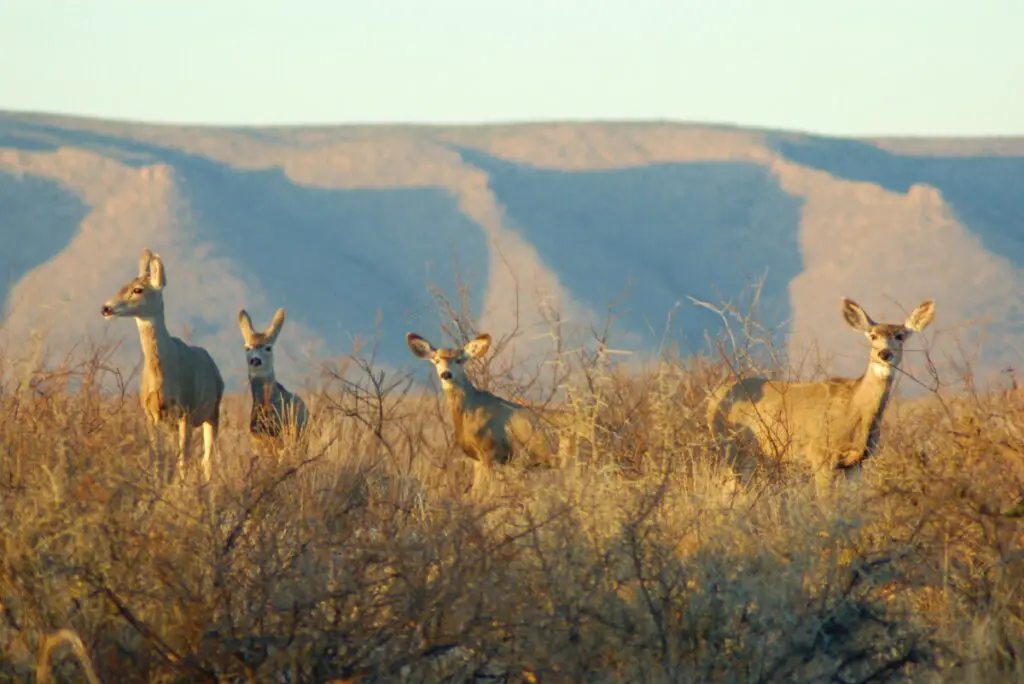
There’s nothing better than eating some delicious venison. The meat is lean, healthy, and full of protein. It’s also very tasty, which makes it perfect for grilling in the summertime.
However, there is a debate about which type of deer tastes better: mule deer or whitetail? We’re going to break down the differences between these two types of deer so that you can make an informed choice when deciding which game to pursue for the best eating.
Whitetail deer tend to eat more leafy greens and corn, and thus the meat tends to be a little less gamey. Mule deer on the other hand has a distinct flavor that a lot of people like, which stems from their diet of shrubs in the pine tree and sagebrush mixed countryside.
Differences Between Mule Deer and Whitetail Deer
When it comes to deer hunting, mule deer and whitetail deer are your only game in town. Whitetail dominate the eastern and midwest regions of the US and out west, we have both.
Both species have a rich history in America and both have benefitted from the conservation efforts of many hunters over the years. However, there are some differences between mule deer and whitetail deer that you need to keep in mind when you’re out hunting.
Distinct Properties of Mule Deer
With an estimated population of almost 3.5 million, mule deer are one of the most populous deer species in the western United States. These deer are known for their long ears and white rump patch that can be used to distinguish them from other species such as white-tailed deer.
Featuring a tannish brown coat, mule deer have a distinctive black-tipped tail that can be seen from a distance when they run through their habitat. This helps them to blend into their surroundings and avoid predators.
Mule deer are considered a very adaptable species, and they have been able to live in a wide range of habitats. They prefer mountainous areas but can also be found in forests, plains, deserts, and even swamps.
They are generally solitary creatures that move throughout their habitat at night looking for food. Since these deers are herbivores, their diet consists of a variety of plant-based foods like the tips of shrubs, twigs, and nearby berries.
Mule deer are a browsing animal when it comes to eating. They move through an area and pick the most readily available food and then move on as opposed to a grazing animal like an elk who behaves more like cattle.
If you are thinking about planning your first mule deer hunt check out this article on the pros and cons of a guided hunt.
Characteristics of Whitetail Deer
The whitetail deer is the most common species of deer in North America. They are characterized by their white tail which is used as a warning sign to other deer when they are frightened or threatened.
The color of their coat varies depending on where they live but generally ranges from brown to reddish-brown with a light underside. They are fairly small animals but can weigh up to 300 pounds and stand over 4 feet tall at the shoulder.
They have a number of adaptations that allow them to survive in their environment including the ability to run up to 48 miles per hour and jump over 10 feet in the air. They have a keen sense of smell, hearing, and sight which help them hunt for food in the wild.
Just like their cousins, white-tailed deer are herbivores and eat a variety of leaves, fruits, and berries. They also eat nuts, corn, acorns, and twigs.
Difference Between the Flavor
Now that you have an idea about the physical characteristics of both deer, let’s take a look at the difference between their flavor. Just like other animals, the flavor of deer depends upon its age, sex, and diet.
For instance, the deer that has been eating alfalfa and other grain-based diets will be more tender and have a milder flavor compared to the ones that have been eating acorns and other nuts.
The same thing can be said about the deer that is younger or older. As a general rule, the older deer will have a stronger flavor than the younger ones. This is because they have tough muscles, resulting in chewy meat.
While most people like the strong flavor of mule deer, others may prefer the milder taste of white-tail deer. It all depends on your personal preference and how you cook it. However, if you are planning to cook a deer for the first time, it is best to start with a young white-tail deer as opposed to an older mule deer.
(Pinetrees and solitude may earn a commission from affiliate links in this article.)
Different Ways To Cook Mule Deer and Whitetail Deer
Mule deer are a little bit more challenging to cook than whitetail deer. They have a lot of strong connective tissue, which can make it difficult to get the meat tender.
You might want to invest a good wild game-specific cookbook to guide you on different recipes. Something like this cookbook from Steve Rinella might be a good choice. That said, there are a lot of ways you can cook mule deer and whitetail deer, so let’s get into it!
Slow Cooked Venison
Slow cooker recipes are great for tough cuts of meat like tri-tip roasts or briskets. The low temperature for several hours allows the meat to tenderize and become easy to cut.
This recipe uses a simple rub of salt and pepper, then slow cooks until the meat falls apart. It makes an excellent meal on its own or can be used as the base for tacos or burritos. You could also serve it with potatoes or rice in addition to cornbread if you wanted to add some carbs into the mix.
Grilled Venison
Grilling is another great way to cook mule deer because it gives you control over how well done your meat is cooked. You can choose whether you want medium rare, medium, or well done by adjusting the heat level on your grill during cooking time.
This recipe uses an herb rub that includes rosemary and thyme along with garlic and lemon to make a great marinade. The citrus flavor of the lemon cuts through the gamey taste of mule deer meat, which makes it a delicious choice for those who prefer venison with a little less flavor than other types of game meat.
Venison Hamburger
Hamburgers are another popular way to prepare venison meat. They can be cooked on the grill or in a skillet and served with your favorite toppings. This recipe uses venison burger patties made from ground mule deer meat, onions, and garlic along with Worcestershire sauce and mustard for flavoring.
The result is a simple yet delicious burger that is sure to become one of your favorites!
Pro tip: The key to making good burgers is not overworking the meat, which means you should only mix it until all ingredients are incorporated together. Since venison is quite lean, you might have to add pork or beef fat to stabilize the texture.
Venison Jerky
One of the most popular ways to cook mule deer and whitetail deer is by making venison jerky. The meat is sliced very thin and then marinated in a mixture of soy sauce, brown sugar, and vinegar. Then, it is dried out using an oven or dehydrator until it becomes hard and crispy.
There are many different ways to make venison jerky, but there is one common rule: it needs to be very dry. This helps it stay fresh for longer periods of time and makes it more palatable than other types of dried meat. You can also add your favorite spices and seasonings to create a flavor that suits your taste buds!
Venison Meatballs
If you want to make a quick and easy dish, venison meatballs are a great option. You can use ground venison or steaks, but if you do use steaks, make sure they are cut into small pieces first.
If you want your meatballs to taste more like traditional Italian food than wild game, then try adding some spices such as garlic powder, onion powder, and oregano to your mixture.
After that, all you need to do is mix together the meat with breadcrumbs, forming balls around golf ball size. Then, fry them in olive oil until they are cooked through and browned on all sides. You can serve them with a marinara sauce for dipping!
Mistakes To Avoid While Making Venison
If you’re not a chef, or if you’ve never cooked venison or deer meat before, you might be surprised at how easy it is to mess up. Here are some mistakes to avoid while making venison:
- While most people think that deer fat tastes as good as beef fat, it’s far from the truth. In fact, it has a “gamier” taste. So, before cooking it, you must trim the sinew, silver skin, and other connective tissues properly.
- Never use dirty knives or power saws because they can transfer bacteria to your venison. Instead, use a clean and sharp knife or blade.
- Venison is best served medium rare or medium, so take it off of the grill or stovetop when it’s done cooking.
- The marinade does wonders for tenderizing the meat and bringing out its unique flavor profile by infusing it with spices and herbs that complement the venison’s, natural sweetness. But when roasting venison, don’t leave it in the marinade for more than three hours because it can make the meat chewy and tough.
Conclusion
In conclusion, mule deer and whitetail deer are both excellent animals to hunt. The taste of the meat is somewhat different yet delicious, so either way, you’ll be satisfied! If you have never hunted before but want to try something new this season then picking up a rifle or bow and heading out into the woods might just be what you need.
If you enjoyed this article, here are some more helpful articles from Pinetrees And Solitude.
- What You Need For An Idaho Mule Deer Hunt
- Catch Mule Deer While They Are Active
- What Should I Bring Elk Hunting? Idaho List
- Hunting Elk In Timber: Tactics To Even The Odds
(This article was originally published on Pintreesandsolitude.com. If it is now published on any other site, it was done without permission from the copyright owner.)
